Design Day Spring 2023
Design Day is an opportunity to share our Senior Design Showcase with the public. Seniors work in groups with faculty to design and test projects.
Senior Design Projects: Spring 2023
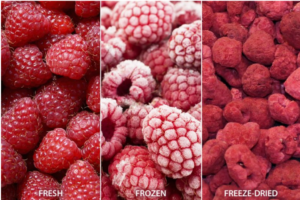 We are seeking to reduce over drying in our sponsors product, enabling them to run more cycles, and create more product in less time. We are doing this by measuring the change in mass of the product in order to measure moisture content. This will ensure that once the product is sufficiently dried we are able to remove it from the drying chamber in as little time as possible.
We are seeking to reduce over drying in our sponsors product, enabling them to run more cycles, and create more product in less time. We are doing this by measuring the change in mass of the product in order to measure moisture content. This will ensure that once the product is sufficiently dried we are able to remove it from the drying chamber in as little time as possible.
Team: John Livingston (lead), Branden Webb, Emerson Powell, Bennie Okamoto
Leads: Dr. Sameer Rao, Dr. Keunhan Park
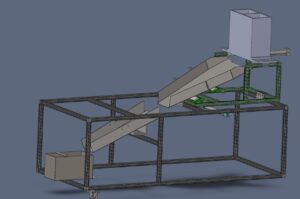 At Rio Tinto, one of the final steps in the copper cathode production includes the submission of copper buttons for assay. The goal of this project was to characterize the loss of these samples and implement a redesign in order to minimize losses at each component of the collection system.
At Rio Tinto, one of the final steps in the copper cathode production includes the submission of copper buttons for assay. The goal of this project was to characterize the loss of these samples and implement a redesign in order to minimize losses at each component of the collection system.
Team: Michale Lopez (lead), Jason Pham, Val Bejerano, Belester Navarrete, Elio Perretta, Ellis Kahn
Advisor: Dr. A.K. Balaji
Heat sinks drive heat dissipation, resulting in extended longevity and improved performance of mechanical/electrical components. Testing heat sinks is expensive and time consuming, so a standardized heat sink testing chamber capable of analyzing thermal performance of various designs would result in accelerated testing and deployment at a reduced cost. Additionally, a physical testing chamber allows for the testing of unconventional heat sink designs. By calculating heat transfer coefficient and pressure drop, we can compare the performance of different heat sink shapes.
Team: Julia Gatto (Lead), Zach Lin, Insa Norcross, Isabel Longoria, Aleks Vazquez, Benjamin Wadsworth
Advisor: Randall Morrill
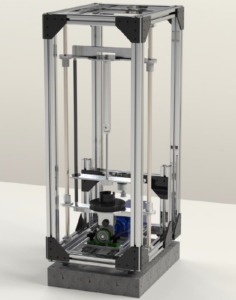 A generant compaction station capable of shaking, rotating, and pressing. The machine will be a lab tool used by Autoliv for testing the best combination of methods to compress the generant material.
A generant compaction station capable of shaking, rotating, and pressing. The machine will be a lab tool used by Autoliv for testing the best combination of methods to compress the generant material.
Team: Edward Santiago, Dallen Unruh, Adam Jost, Jackson Vanderberghe. Drew Prescott, Evan Peck
Advisor: Dr. Pedro Huebner
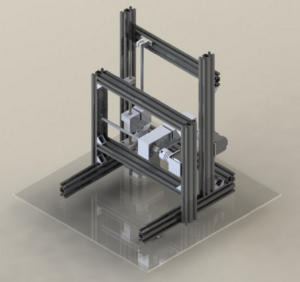 Tasked with evaluating the longevity of Northrop’s guide-by-wire system for their automated guide vehicles transporting their mixed rocket fuel. The integrity of the guide system has been called into question by the original installing company. Due to an operational guide system being crucial to Northrop’s operations, Northrop has asked our team to independently evaluate the wire condition for if/when it may fail.
Tasked with evaluating the longevity of Northrop’s guide-by-wire system for their automated guide vehicles transporting their mixed rocket fuel. The integrity of the guide system has been called into question by the original installing company. Due to an operational guide system being crucial to Northrop’s operations, Northrop has asked our team to independently evaluate the wire condition for if/when it may fail.
Team: Trevor Johnson (lead), Caleb Norman, Cameron Schwartz, Colby Lynch, Derrick Moss, Skyler Little
Advisor: Dr. Mark Minor
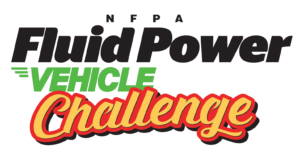 The team is to compete in the fluid power vehicle competition hosted by the National Fluid Power Association. The competition requires designing a human-powered vehicle that utilizes a hydraulic system to provide propulsion in a series of races such as the sprint, efficiency, endurance, and regeneration race.
The team is to compete in the fluid power vehicle competition hosted by the National Fluid Power Association. The competition requires designing a human-powered vehicle that utilizes a hydraulic system to provide propulsion in a series of races such as the sprint, efficiency, endurance, and regeneration race.
Team: Mathis Lethier (lead), Patrick McGann, Jared Tambaschi, Alex Nickisch, Seth Roundy
Advisor: Dr. M Metzger
The participating student competition teams design, analyze, and optimize an additively manufactured heat sink to cool a constant power module subject to natural convection in a vertical enclosure. The teams that are evaluated as having the most effective designs exploiting the design freedom allowed by additive manufacturing, will have the opportunity to have their designs printed at GE and experimentally tested at the University of Southern Denmark. The finalists will be invited to present their work at the 2023 ITherm conference.
Team: Chandler Elliott (lead), Xander Lehnardt, Preston Bodily, Taylor Cox, Zach Julien
Advisors: Dr. Sameer Rao, Dr. Tianli Feng, Dr. Samira Shiri
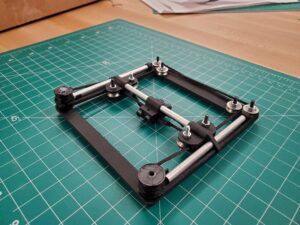 A system that will be able to track shoulder movement and deliver haptic feedback in the form of a moving ball to the user’s chest. The purpose of the system is to serve as a physical therapy device for patients that have lost their proprioceptive sense on half of their body.
A system that will be able to track shoulder movement and deliver haptic feedback in the form of a moving ball to the user’s chest. The purpose of the system is to serve as a physical therapy device for patients that have lost their proprioceptive sense on half of their body.
Team: Arthur Monteiro (lead), Ethan Bollwinkel, Mckkay Ashby, Olivia Richards, Benjamin Smith, Preston Irwin
Advisor: Dr. Edoardo Battaglia
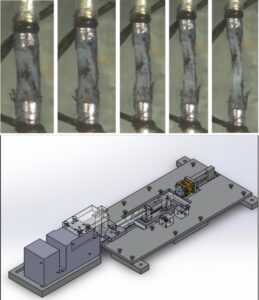 The Head Injury and Vessel Biomechanics Lab aims to analyze and characterize injury-induced changes in cerebral vessel behavior. Dr. Ken Monson’s lab uses a tester to perform tension tests on blood vessels and gather strain values using digital image correlation (DIC) techniques. The current tester can gather strain values in two dimensions; however, three-dimensional strain values are more valuable to the research of the lab. Therefore, we are tasked with modifying the tester to gather and analyze strain values around the full circumference of the blood vessel while it undergoes testing.
The Head Injury and Vessel Biomechanics Lab aims to analyze and characterize injury-induced changes in cerebral vessel behavior. Dr. Ken Monson’s lab uses a tester to perform tension tests on blood vessels and gather strain values using digital image correlation (DIC) techniques. The current tester can gather strain values in two dimensions; however, three-dimensional strain values are more valuable to the research of the lab. Therefore, we are tasked with modifying the tester to gather and analyze strain values around the full circumference of the blood vessel while it undergoes testing.
Team: Audrey Pohl (lead), Jasmine Knowles, Julia Olsen, Andre Otero, Ethan Albrechtsen, Arham Irshad
Advisor: Dr. Ken Monson
Our team is designing and constructing a programable microwave furnace for the Bioinspired Science & Engineering Lab Group at the University of Utah. The microwave furnace must be able to sinter samples at least as well as conventional sintering techniques can. It must be able to heat samples to an interior temperature of 1500°C, be able to hold samples at specific temperatures for desired lengths of time, and have an easy to operate user interface with programmable sintering routines.
Team: Gabe Shuster (lead), Reilly Beckstrand, Gage Coleman, Tyler Hollings
Advisor: Dr. Steven Naleway, Tony Yin
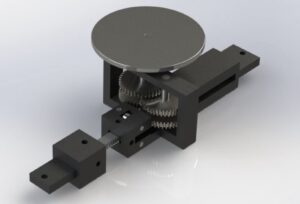 Mechanical inerters were tightly kept as the top business secret, under and codename “J-damper” by the Formula-1 team McLaren for years. The flywheelis one of the critical parts of inerters. Because of the powerful performance ofdynamic response, the disk cam mechanism is widely employed in manyapplications in various fields, like engine, machine tools, gear-cutting machines,etc. The mechanism allows transforming small linear oscillating displacementtransmissions to the cam’s rotary motion. It has the advantage that the follower has specified kinematic characteristics with a high level of precision.
Mechanical inerters were tightly kept as the top business secret, under and codename “J-damper” by the Formula-1 team McLaren for years. The flywheelis one of the critical parts of inerters. Because of the powerful performance ofdynamic response, the disk cam mechanism is widely employed in manyapplications in various fields, like engine, machine tools, gear-cutting machines,etc. The mechanism allows transforming small linear oscillating displacementtransmissions to the cam’s rotary motion. It has the advantage that the follower has specified kinematic characteristics with a high level of precision.
Team: Chad Hickey (lead), Jan Cas, Michael Turja, Jack Godfrey, Jack Platt, Tyler Silva
Advisors: Dr. Pai Wang, Fei Chen
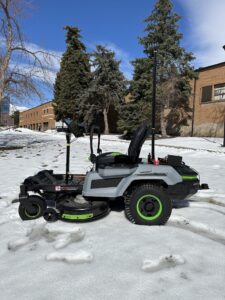 The CPSC has growing concern about riding lawn mowers due to large numbers of ride-over incidents. We were tasked with implementing safety systems to prevent these incidents and increase the safety of riding lawn mowers.
The CPSC has growing concern about riding lawn mowers due to large numbers of ride-over incidents. We were tasked with implementing safety systems to prevent these incidents and increase the safety of riding lawn mowers.
Team: Spencer Kirkham (lead), Lowell Dixon, Andrew Youngberg, Saud Alkhaldi, Jincheng Sun
Advisor: Dr Ken d’Entremont
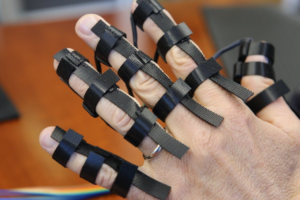 After a stroke, the cortical pathways within the brain can become scrambled. This can lead to stroke patients having jumbled senses in their hands. For example, a patient could receive a stimulus to their thumb, but the perceived stimulus is in the ring finger. Current therapy for stroke patients aims to reestablish hand mobility and functionality, but there is an intrinsic difficulty in reestablishing these cortical pathways. This project is aimed at addressing these jumbled cortical pathways by creating a first step in physical therapy for stroke patients on the affected hand. Our device will be used in future therapies by providing vibrational stimulus to a patient’s hand in different locations. The vibrational stimulus is then paired with a visual indicator in the corresponding location of the vibration. The resulting therapy techniques will aim to help patients connect the perceived location of sensation with the true location on the hand, thereby helping to reconnect and rearrange the affected cortical pathways.
After a stroke, the cortical pathways within the brain can become scrambled. This can lead to stroke patients having jumbled senses in their hands. For example, a patient could receive a stimulus to their thumb, but the perceived stimulus is in the ring finger. Current therapy for stroke patients aims to reestablish hand mobility and functionality, but there is an intrinsic difficulty in reestablishing these cortical pathways. This project is aimed at addressing these jumbled cortical pathways by creating a first step in physical therapy for stroke patients on the affected hand. Our device will be used in future therapies by providing vibrational stimulus to a patient’s hand in different locations. The vibrational stimulus is then paired with a visual indicator in the corresponding location of the vibration. The resulting therapy techniques will aim to help patients connect the perceived location of sensation with the true location on the hand, thereby helping to reconnect and rearrange the affected cortical pathways.
Team: Levi Barker (lead), Melissa Frisby, Jordan Callus, Ethan Hawkins, Jason Bermudez Hernandez
Advisors: Dr. Sanford Meek, Dr. Mohmmed Sbai
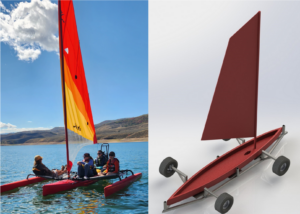 The Technology Recreation Access Independence Lifestyle Sports (TRAILS) program directed by Utah Health’s Craig H. Neilsen Rehabilitation Hospital enables patients with complex physical disabilities to engage in recreational activities they otherwise could not participate in. TRAILS developed a Tetra Watercraft controlled with sip and puff straws that allows patients to go sailing. They would like to enable it to go land sailing. Our objective is to adapt the Tetra Watercraft to land by designing a wheeled chassis to house the craft and interact with the existing controls, providing electric steering and motor power as needed.
The Technology Recreation Access Independence Lifestyle Sports (TRAILS) program directed by Utah Health’s Craig H. Neilsen Rehabilitation Hospital enables patients with complex physical disabilities to engage in recreational activities they otherwise could not participate in. TRAILS developed a Tetra Watercraft controlled with sip and puff straws that allows patients to go sailing. They would like to enable it to go land sailing. Our objective is to adapt the Tetra Watercraft to land by designing a wheeled chassis to house the craft and interact with the existing controls, providing electric steering and motor power as needed.
Team: Tanner Short (lead), Jordan Manor, Freddie Rice, Maria Salzetti, David Sieverts, Jonthan Wang
Advisors: Dr. Kam Leang, Ross Imburgia
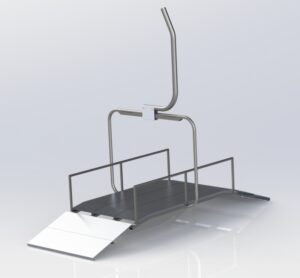 Lift serviced downhill mountain biking is a fun addition to mountain biking but is currently ill-suited to service adaptive bikes and riders. The main goal of this project is to design a lift that is not only quicker when loading and unloading these riders and bikes, but also, a lift where the rider can stay in their bike the entire time. The design is capable of carrying a single adaptive rider and their bike as well as an assistant.
Lift serviced downhill mountain biking is a fun addition to mountain biking but is currently ill-suited to service adaptive bikes and riders. The main goal of this project is to design a lift that is not only quicker when loading and unloading these riders and bikes, but also, a lift where the rider can stay in their bike the entire time. The design is capable of carrying a single adaptive rider and their bike as well as an assistant.
Team: Ashleigh Bicknell (lead), Taylor Kalensky, Connor Gromko, Alex Forsberg, Jesse Prime, Will Tesseyman
Advisor: Dr. Stephen Mascaro
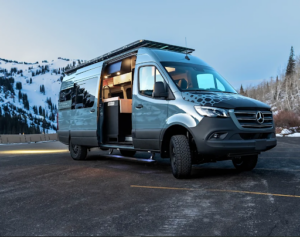 Off Highway Van (OHV) is a luxury van-life company that builds custom interiors for the Mercedes Sprinter van. OHV wants to offer their customers a permanent bed system that can be lowered into a comfortable position for sleeping, and then raised to the ceiling when not in use. Clients control the electromechanical system by using a button-based human-machine interface. The design is low-profile, in order to maximize useful space in the cargo area and to encourage future concealment of the rail system. These aspects make the product appealing to a broader client base. The additional cargo space created while the bed is in the high position allows clients to store large recreational equipment such as dirt bikes inside their van while traveling. The lift bed adds versatility and value to the current van layouts.
Off Highway Van (OHV) is a luxury van-life company that builds custom interiors for the Mercedes Sprinter van. OHV wants to offer their customers a permanent bed system that can be lowered into a comfortable position for sleeping, and then raised to the ceiling when not in use. Clients control the electromechanical system by using a button-based human-machine interface. The design is low-profile, in order to maximize useful space in the cargo area and to encourage future concealment of the rail system. These aspects make the product appealing to a broader client base. The additional cargo space created while the bed is in the high position allows clients to store large recreational equipment such as dirt bikes inside their van while traveling. The lift bed adds versatility and value to the current van layouts.
Team: Zach Ruble (lead), Sam Parry, Elle-Rose Knudson, Treyvon Sidberry, Josh Teerlink, Ebsa Eshete
Advisor: Dr. Owen Kingstedt
Sponsor: Off Highway Van
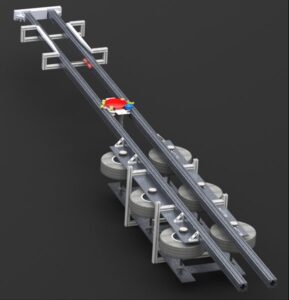 As disc golf becomes more popular, players may note that the four characteristics used to rate discs are not standardized. Our launcher is the beginning of a consistent, adjustable machine used to test a frisbee’s launch velocity, rotational velocity, launch angle, release angle, effects of differing disc diameters, and other important factors.
As disc golf becomes more popular, players may note that the four characteristics used to rate discs are not standardized. Our launcher is the beginning of a consistent, adjustable machine used to test a frisbee’s launch velocity, rotational velocity, launch angle, release angle, effects of differing disc diameters, and other important factors.
Team: Dylan Wyatt (lead), Bronte Weller, Tara Jeppsen, Mathias Schoen
Advisor: Dr. Todd Easton
Industry Sponsor: GRIP6